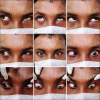Clinical profile and magnetic resonance imaging characteristics of Duane retraction syndrome
- PMID: 35937749
- PMCID: PMC9351951
- DOI: 10.4103/ojo.ojo_133_21
Clinical profile and magnetic resonance imaging characteristics of Duane retraction syndrome
Abstract
Purpose: To describe the clinical profile and magnetic resonance imaging findings of the brain in Duane retraction syndrome (DRS) and determine whether there is an association between clinical presentation and magnetic resonance imaging (MRI) brain characteristics.
Materials and methods: This was a cross-sectional study done at a tertiary care center in South India. We recruited and analyzed the clinical characteristics of 54 patients with DRS. MRI of the brain with fast imaging employing steady-state acquisition (FIESTA) was performed in 41 cases, and the cisternal segment of the sixth nerve was studied. Statistical analysis was done to determine any association between the radiological and clinical features.
Results: Type 1 DRS was predominant, followed by Type 3 DRS and Type 2 DRS. 9.3% of cases were bilateral and 11.1% were familial. Orthotropia was most common, followed by esotropia and exotropia. The MRI brain showed the absence of the cisternal part of the sixth nerve on the affected side in 82% of Type 1 and 75% of Type 3 unilateral DRS. Both the abducens nerves were visualized in 19.5% of the patients with unilateral DRS. There was no statistically significant association between MRI brain findings and the clinical features.
Conclusions: MRI brain with FIESTA shows absent or hypoplastic sixth nerve in most cases of Type 1 and Type 3 DRS. However, around 20% of DRS cases may show the presence of the cisternal part of the sixth nerve. Hence, clinicians must be cautious when ruling out DRS on the basis of MRI brain findings. Although aplasia of the sixth nerve is the most frequent MRI finding, it may not be the sole etiologic factor.
Keywords: Abducens nerve; Duane retraction syndrome; fast imaging employing steady-state acquisition; magnetic resonance imaging.
Copyright: © 2022 Oman Ophthalmic Society.
Conflict of interest statement
There are no conflicts of interest.
Figures



Similar articles
-
Magnetic Resonance Imaging Findings in Patients With Duane Retraction Syndrome.J Neuroophthalmol. 2024 Mar 1;44(1):101-106. doi: 10.1097/WNO.0000000000001909. Epub 2023 Sep 8. J Neuroophthalmol. 2024. PMID: 37682628 Free PMC article.
-
Duane retraction syndrome: MRI features in two cases.J Neuroradiol. 2007 May;34(2):137-40. doi: 10.1016/j.neurad.2007.01.002. J Neuroradiol. 2007. PMID: 17320174
-
Abducens Nerve in Patients with Type 3 Duane's Retraction Syndrome.PLoS One. 2016 Jun 28;11(6):e0150670. doi: 10.1371/journal.pone.0150670. eCollection 2016. PLoS One. 2016. PMID: 27352171 Free PMC article.
-
Duane retraction syndrome.Ophthalmol Clin North Am. 2001 Sep;14(3):407-17. doi: 10.1016/s0896-1549(05)70238-8. Ophthalmol Clin North Am. 2001. PMID: 11705140 Review.
-
Duane retraction syndrome: causes, effects and management strategies.Clin Ophthalmol. 2017 Oct 30;11:1917-1930. doi: 10.2147/OPTH.S127481. eCollection 2017. Clin Ophthalmol. 2017. PMID: 29133973 Free PMC article. Review.
Cited by
-
Two novel CHN1 variants identified in Duane retraction syndrome pedigrees disrupt development of ocular motor nerves in zebrafish.J Hum Genet. 2024 Jan;69(1):33-39. doi: 10.1038/s10038-023-01201-w. Epub 2023 Oct 18. J Hum Genet. 2024. PMID: 37853116
-
Duane retraction syndrome: Where and how is the abducens nerve?Oman J Ophthalmol. 2022 Jun 29;15(2):131-132. doi: 10.4103/ojo.ojo_141_22. eCollection 2022 May-Aug. Oman J Ophthalmol. 2022. PMID: 35937726 Free PMC article. No abstract available.
References
-
- Duane A. Congenital deficiency of abduction, associated with impairment of adduction, retraction movements, contraction of the palpebral fissure and oblique movements of the eye.1905. Arch Ophthalmol. 1996;114:1255–6. - PubMed
-
- Breinin GM. In Discussion of: De Gindersen T, Zeavin B. Observations on the retraction syndrome of Duane. Arch Ophthalmol. 1956;55:576.
-
- Hoyt WF, Nachtigäller H. Anomalies of ocular motor nerves. Neuroanatomic correlates of paradoxical innervation in Duane's syndrome and related congenital ocular motor disorders. Am J Ophthalmol. 1965;60:443–8. - PubMed
-
- Hotchkiss MG, Miller NR, Clark AW, Green WR. Bilateral Duane's retraction syndrome. A clinical-pathologic case report. Arch Ophthalmol. 1980;98:870–4. - PubMed
-
- Gutowski NJ, Bosley TM, Engle EC. 110th ENMC International Workshop: The congenital cranial dysinnervation disorders (CCDDs). Naarden, The Netherlands, 25-27 October, 2002. Neuromuscul Disord. 2003;13:573–8. - PubMed
LinkOut - more resources
Full Text Sources
